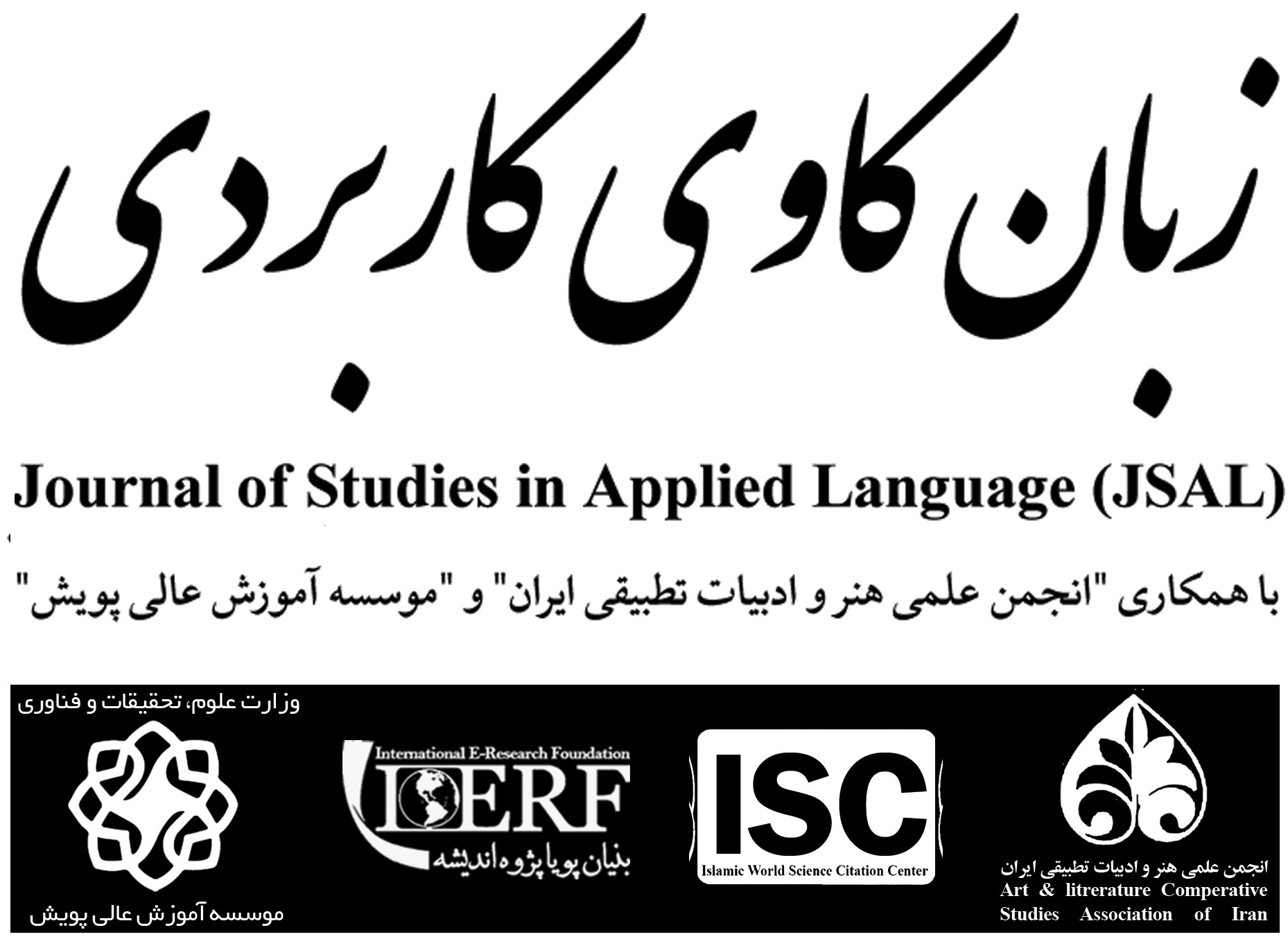<>
Volume 6, Issue 2 (4-2023)
JSAL 2023, 6(2): 1-15 |
Back to browse issues page
Download citation:
BibTeX | RIS | EndNote | Medlars | ProCite | Reference Manager | RefWorks
Send citation to:



BibTeX | RIS | EndNote | Medlars | ProCite | Reference Manager | RefWorks
Send citation to:
Imani Z. (2023). A Semantic Analysis of the Verb dowr zædæn (to turn around) in Persian: A FrameNet-Based Account [In English]. JSAL. 6(2), 1-15. doi:10.52547/jsal.6.2.1
URL: http://jsal.ierf.ir/article-1-27-en.html
URL: http://jsal.ierf.ir/article-1-27-en.html
PhD Candidate in General Linguistics, Faculty of Foreign Languages, University of Isfahan , zolfa.imani.1985@gmail.com
Abstract: (4331 Views)
The investigation of semantic frames evoked by various syntactic categories has always been the focus of study in the field of cognitive linguistics. Here, the syntactic category is a verb and the hypothesis is that as the verb dowr zᴂdᴂn (to turn around) is a polysemous motion verb in Persian, it is expected that just as there is an association among its meanings, there will also be a relation among the semantic frames evoked by it. In order to test the hypothesis, the findings of this research, which are composed of different situations where the verb was used, were extracted from the Persian Corpus of Bijankhan at the first stage. Then, the duplicate cases were eliminated so that only one type of each situation would remain. Having been translated into English and searched through the FrameNet database, the Persian cases alongside their frames were compared and analysed; as a result of which, it was identified that the hypothesis was confirmed, as there is a semantic association among the semantic frames the polysemous motion verb in question evokes—revolving around an object or deviating from the main path.
Type of Study: Research |
Subject:
Sociolinguistics
Received: 2021/03/21 | Accepted: 2022/06/2 | Published: 2023/04/22
Received: 2021/03/21 | Accepted: 2022/06/2 | Published: 2023/04/22
References
1. Ardeshir Jey, Sh. (1959). A dictionary of Persian-English idioms. 3th edition. Tehran: Tehran University Press.
2. Aryanpur, A. & Aryanpur, M. (2008). The pocket Persian English dictionary. Teheran: Amir Kabir Publishing Institute.
3. Aryanpur, M. (2007). The Aryanpur progressive Persian-English dictionary: One volume, mini companion. Tehran: Jahan Rayaneh Publishing.
4. Baker, C. F. & Ruppenhofer, J. (2002). Framenet's frames vs. Levin's verb classes. Computer Science. [DOI:10.3765/bls.v28i1.3816]
5. Baker, Collin F., Fillmore, C. J. & Lowe, J. B. (1998). The Berkeley FrameNet project. Proceedings of the 17th International Conferenvce on Computational Linguistics. Vol. 1, pp. 86-90. [DOI:10.3115/980451.980860]
6. Cristobal, M. (2001). "Arriving Events in English and Spanish: A Contrastive Analysis in terms of Frame Semantics". International Computer Science Institute Technical Reports, Estudios de lingüística del español, Vol. 31, pp 01-09.
7. Dekova, R. & Nestorova, P. I. (2008). Verbs of movement in the Bulgarian FrameNet. In Papanikos, G. T. (Ed.) Literature, Language & Linguistics.
8. Fillmore, C. J. (1977a). "The case for case reopened". In P. Cole, & J. Sadock, Syntax and Semantics 8: Grammatical Relations, New York: Academic Press, pp. 59-81. Doi: 10.1163/9789004368866_005 [DOI:10.1163/9789004368866_005]
9. Fillmore, C. J. (1977b). "Scenes and frames semantics". In A. Zampolli, Linguistic Structures Processing. Fundamental Studies in Computer Science, Amesterdam: North Holland, Vol. 5, pp. 55-81.
10. Fillmore, C. J. (1977c). Topics in lexical semantics. In R. W. Cole, Current Issues in Linguistic Theory. Bloomington: Indiana University Press.
11. Fillmore, C. J. (1982). "Frame semantics". The Linguistic Society of Korea: Linguistic in the Morning Calm, pp. 65-173.
12. Fillmore, C. J. (1985). "Frames and the semantics of understanding". Quaderni di Semantica, No. 6, pp. 222-254.
13. Fillmore, C. J. (2006). "Frame semantics". In K. Allan, Concise Encyclopedia of Semantics, Oxford/ Amesterdam. Elsevier, pp. 613-620. [DOI:10.1016/B0-08-044854-2/00424-7]
14. Ghaffari, S. (2007). Aborz two-way companion dictionary: English-Persian & Persian-English. Tehran: Asim Press.
15. Hamedi Shirvan Z, Sharifi S. (2014) "A Typological Analysis of Satellite in the Event Structure of Motion Verbs in Persian", LRR, Vol. 5, No. 2, pp. 71-89.
16. Imani, Z. & Motavallian, R. (2020a). "Motion verbs of manner in FrameNet: A comparison between Persian and English." Kervan, Vol. 24, No. 1, pp. 107-122. Doi: 10.13135/1825-263X/4106
17. Imani, Z. & Motavallian, R. (2020b). "he Study of Semantic Frames and the Way of Expressing Direction in Persian Motion Verbs: Case of "Come" and "Go"". Journal of Western Iranian Languages and Dialects, Vol. 8, No, 3, pp. 1-11. Doi: 10.22126/jlw.2020.4754.1380.
18. Imani, Z. & Motavallian, R. (2020c). "Motion verbs in Persian and English: A FrameNet-based contrastive analysis." Facta Universitatis: Linguistics and Literature, Vol. 18, No. 2, pp. 195-205. Doi: 10.22190/FULL2002195I [DOI:10.22190/FULL2002195I]
19. Levin, B. (1993). English verb classes and alternation: a preliminary investigation. Chicago: The University of Chicago Press.
20. Nazari Teimoori, E. (2005). A dictionary of proverbs and colloquial idioms. 3th edition. Tehran: Yadvareh Ketab Publishing.
21. Petruck, M. R. L. (1997). "Framing motion in Hebrew and English". In R. Rossini Favretti (ed.), FramesCorpora and Knowledge Representation. Bologna: Bologna UniversityPress, pp. 43-51.
22. Talmy, L. (1972). Semantic Structures in English and Atsugewi. Doctoral dissertation, University of Clifornia, Berkeley.
23. Talmy, L. (1985). Lexicalization Patterns: Semantic Structure in Lexical Forms, in T. Shopen (ed.) Language Typology and Syntactic Description 3, Cambridge University Press.
24. Talmy, L. (2000a). Toward a cognitive semantics. Vol. II. Cambridge: MIT Press. [DOI:10.7551/mitpress/6847.001.0001]
25. Talmy, L.(2000b). Toward a cognitive semantics. Vol. II. Cambridge: MIT Press. [DOI:10.7551/mitpress/6847.001.0001]
Send email to the article author
| Rights and permissions | |
 |
This work is licensed under a Creative Commons Attribution-NonCommercial 4.0 International License. |








